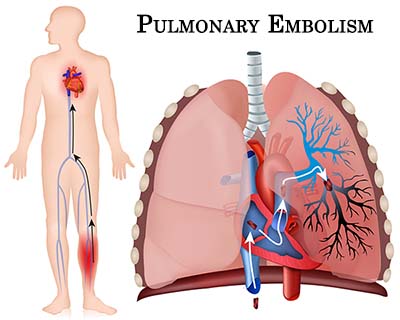- Home
- Editorial
- News
- Practice Guidelines
- Anesthesiology Guidelines
- Cancer Guidelines
- Cardiac Sciences Guidelines
- Critical Care Guidelines
- Dentistry Guidelines
- Dermatology Guidelines
- Diabetes and Endo Guidelines
- Diagnostics Guidelines
- ENT Guidelines
- Featured Practice Guidelines
- Gastroenterology Guidelines
- Geriatrics Guidelines
- Medicine Guidelines
- Nephrology Guidelines
- Neurosciences Guidelines
- Obs and Gynae Guidelines
- Ophthalmology Guidelines
- Orthopaedics Guidelines
- Paediatrics Guidelines
- Psychiatry Guidelines
- Pulmonology Guidelines
- Radiology Guidelines
- Surgery Guidelines
- Urology Guidelines
Better way to interpret blood tests to diagnose pulmonary embolism reduces need for CT scans

HAMILTON, ON - The primary goal of diagnostic testing in Pulmonary Embolism is to identify which patients should be treated with anticoagulant agents and which should not. The patients who should be treated are those who have pulmonary embolism that has a substantial risk of recurrence or progression.
Hamilton researchers have found that a higher than usual D-dimer level can be considered a negative result if the physician has assessed the patient as having a low probability of having a pulmonary embolism. The study has found that the new way to interpret blood test results to rule out the presence of pulmonary embolism will cut the need for CT scans. The study results were published today in the New England Journal of Medicine.
The study team notes the findings are important as they mean a lot fewer patients need a computerized tomography (CT) scan, which results in patients avoiding radiation exposure and spending less time in the emergency department. The health system also benefits, they say, as it frees up CT scans for other patients and it improves the ability to move patients more quickly through the emergency department.
"The primary goal of diagnostic testing for pulmonary embolism is to identify which patients should be treated with anticoagulant agents and which should not," said first author Clive Kearon, professor of medicine at McMaster University and a thrombosis specialist with Hamilton Health Sciences.
"When a physician is concerned that pulmonary embolism may be present, chest imaging with CT pulmonary angiography is usually done in half of these patients. We wanted to find a way to reduce the number of CT scans that need to be done."
A total of 2,017 patients aged 18 and older were enrolled and evaluated in the study, of which seven per cent had pulmonary embolism on initial diagnostic testing. The average age of the patients was 52 years, and 66 per cent were female.
Of the patients in the study, 73 per cent, or 1,474, were enrolled at Hamilton Health Sciences or St. Joseph's Healthcare Hamilton.
These patients and those at other university-based clinical centres in Canada were tested from December 2015 through May 2018 and assessed 90 days later.
Of the 1,325 patients identified by an emergency department physician as having a low (1,285 of the patients) or a moderate (40 patients) probability of having a pulmonary embolism and who had negative D-dimer results (that is, less than 1,000 or 500 nanograms per millilitre (ng/mL) respectively), none had venous thromboembolism during follow-up.
"Our analyses show that pulmonary embolism is ruled out by a D-dimer level of less than 1,000 ng/mL in patients with a low probability, and by a D-dimer level of less than 500 ng/mL in patients with a moderate probability. This way of using D-dimer testing and clinical assessment reduced the need for CT scanning by one-third," said Kearon.
"This was a collaborative study among thrombosis and emergency medicine physicians and researchers. Dr Kerstin de Wit, who is emergency medicine and thrombosis specialist, was key to this research and to the study's translation."
For further reference:
Diagnosis of Pulmonary Embolism with d-Dimer Adjusted to Clinical Probability
MCMASTER UNIVERSITY
Dr Prem Aggarwal, (MD, DNB Medicine, DNB Cardiology) is a Cardiologist by profession and also the Co-founder of Medical Dialogues. He is the Chairman of Sanjeevan Hospital in Central Delhi and also serving as the member of Delhi Medical Council

Disclaimer: This site is primarily intended for healthcare professionals. Any content/information on this website does not replace the advice of medical and/or health professionals and should not be construed as medical/diagnostic advice/endorsement or prescription. Use of this site is subject to our terms of use, privacy policy, advertisement policy. © 2020 Minerva Medical Treatment Pvt Ltd